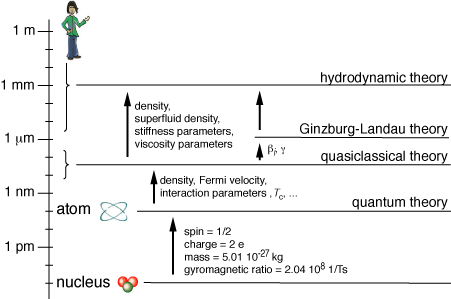Length Scales in Superfluid 3He

The figure presents some length scales that are important in theoretical
studies of superfluid 3He. The shortest scale shown here is the
nuclear scale, 0.01 pm. The nucleus consists of two protons and one neutron.
One 3He atom consists of a nucleus and two circulating electrons.
The size of the atom is approximately 0.1 nm,
four orders of magnitude larger than the nuclear size.
On the atomic scale and on larger scales the nucleus shows up only through
the four parameters listed, the spin, the charge, the mass, and the
gyromagnetic ratio.
The atoms in liquid 3He form a strongly interacting
quantum system.
Presently the theory of this liquid
on the atomic scale is not very accurate.
Fortunately, the behavior on longer length scales can well be understood
with the quasiclassical theory [1].
This theory needs as input some parameters from the atomic level,
in particular
the density of the liquid, the Fermi velocity,
the Landau interaction parameters, and
the superfluid transition temperature Tc.
At present these cannot be calculated at the atomic scale,
but the most important ones can be extracted from experiments.
The quasiclassical theory represents a solution to the many-body
problem of interacting 3He atoms. It becomes exact
in the limit that the superfluid coherence length would be much larger
than the atomic size. Since the coherence length is 15 nm ... 77 nm
(depending on pressure), the quasiclassical theory represents a fairly
good approximation. Instead of bare 3He atoms,
there appears quasiparticles in the quasiclassical theory.
The quasiparticles move like classical particles along (straight)
trajectories, but along each trajectory there is quantum mechanical
interference between particles flying in opposite directions.
The quasiclassical theory contains as special cases the
Bardeen-Cooper-Schrieffer
theory of superconductivity and Landau's theory of Fermi liquids.
For macroscopic problems the quasiclassical theory
is unnecessarily complicated.
These problems can be more effectively studied with a hydrodynamic theory.
The hydrodynamic theory for superfluid 3He is more complicated
than for ordinary liquids because 3He can support frictionless
flow of both mass and spin. In some problems the best approach is to use
the Ginzburg-Landau theory of 3He. This theory works on a scale
that is intermediate between the quasiclassical and hydrodynamic scales.
Both the hydrodynamic and Ginzburg-Landau theory need some input parameters.
It is important that these parameters
can be calculated within the quasiclassical theory, since they are
not easily accessible experimentally.
Examples of calculations at different scales:
- Hydrodynamic theory
- Ginzburg-Landau theory
- Quasiclassical theory
Note that some problems are studied at various length scales.
In particular, for the Josephson effect in a pinhole one has to calculate
interactively on both quasiclassical and hydrodynamic scales.
[1] J.W. Serene and D. Rainer: The quasiclassical approach to
superfluid 3He, Phys. Rep. 101, 221 (1983).
Back to helium theory page,
to 3He page
19.8.2003, Erkki Thuneberg, Email,
Suomeksi
